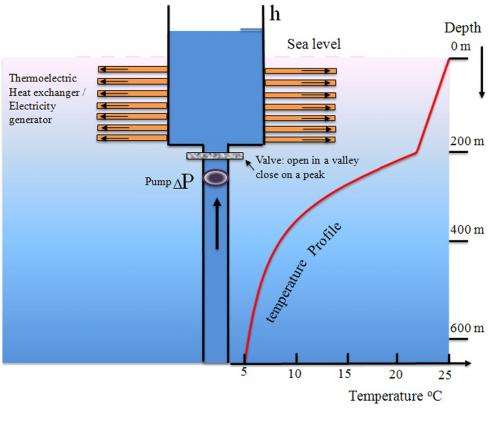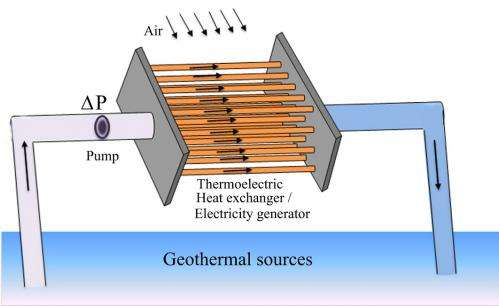A thermoelectric power plant might use energy harvested from ocean waves to pump cold water up through a heat exchanger/generator near the surface. The heat exchanger is made of thermoelectric materials which can use the temperature gradient between the warm and cold water to generate electricity. Credit: Liu. (CC BY 3.0)
(Phys.org)—A new study predicts that large-scale power plants based on thermoelectric effects, such as small temperature differences in ocean water, could generate electricity at a lower cost than photovoltaic power plants.
Liping Liu, Associate Professor at Rutgers University, envisions that thermoelectric power plants would look like giant barges sitting in the tropical ocean, where electricity is generated by heating cold, deep water with warm, shallow water heated by the sun. Liu has published a paper in the New Journal of Physics in which he analyzes the feasibility of such power plants.
"This work is about the new idea of large-scale green power plants that make economic use of the largest accessible and sustainable energy reservoir on the earth," Liu told Phys.org, speaking of the oceans. This is because the sun heats the surface water to a temperature that, in tropical regions, is about 20 K higher than water 600 m deep. Essentially, the surface water acts as a giant storage tank of solar energy.
As Liu explains, thermoelectric power plants would work by harvesting the energy of ocean waves to pump cold water from a few hundred meters deep up through a long channel. As the cold water nears the surface, it enters a heat exchanger where it is heated by surface water on the outside. The heat exchanger acts as an electric generator, as its tubes are made of thermoelectric materials that can transfer heat through their walls and directly convert temperature differences into electricity.
Large-scale, ocean-based thermoelectric power plants would have many advantages. For one, the "fuel" or temperature differences are free, unlimited, and easily accessible. Also, the plants do not take up space on land. Because they have no moving solid parts, they would have low maintenance costs. In addition, the power output does not depend on the time of day or season. And finally, the method is green, as it does not release emissions.
A thermoelectric power plant can also use geothermal sources to produce the temperature gradient. Here, hot water is pumped up to the heat exchanger/generator, where it is cooled by air. Credit: Liu. (CC BY 3.0)
Small-scale thermoelectric generators are already used commercially in applications such as microelectronics, automobiles, and power generation in remote areas. In these designs, the conversion efficiency is the most important factor because the fuel accounts for the largest portion of the cost. Most commercial devices have a conversion efficiency of around 5% to 10% of the ideal Carnot efficiency, with state-of-the-art devices achieving efficiencies of up to 20%. Although research is currently being done to further improve the efficiency, there are still limits to how high it can go.
In the new paper, Liu shows that large-scale thermoelectric power plants wouldn't need to operate at extremely high efficiencies to be economically competitive; instead, the key would lie in engineering simple structures such as laminated composites in order to support mass production. These improvements focus on the conversion capacity, which, unlike efficiency, can be improved by orders of magnitude. In other words, because the fuel is free and in limitless supply, large-scale thermoelectric power plants could make up with their sheer size what they lack in efficiency.
The cost of generating electricity varies by source. According to the US Department of Energy, the estimated cost per year of one megawatt of electricity in 2016 is about $0.83 million for conventional coal plants, compared to $1.84 million for photovoltaic power plants. Liu's analysis estimates that a thermoelectric power plant could generate electricity for less than $1.84 million, although an exact estimate is difficult at this stage. This estimate is for a thermoelectric generator that lasts for 20 years and uses ocean water with a 10 K temperature difference as fuel. If water from geothermal sources is used instead, the temperature difference could be 50 K or more, resulting in an even higher power gain and lower cost per watt.
Overall, the analysis shows that thermoelectric power plants look very promising and could contribute to solving the world's energy problems. Liu plans to work toward this goal in future research.
"We are currently working on experimentally validating the predicted power factor of the thermoelectric composites," Liu said. "Once this is validated, we will seek to fabricate a table-top prototype of the generator that uses ice water and hot water as 'fuel.'"
More information: Liping Liu. "Feasibility of large-scale power plants based on thermoelectric effects." New Journal of Physics. DOI: 10.1088/1367-2630/16/12/123019
Journal information: New Journal of Physics
© 2014 Phys.org
























